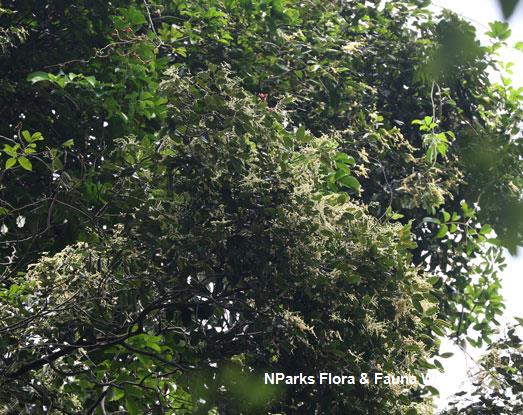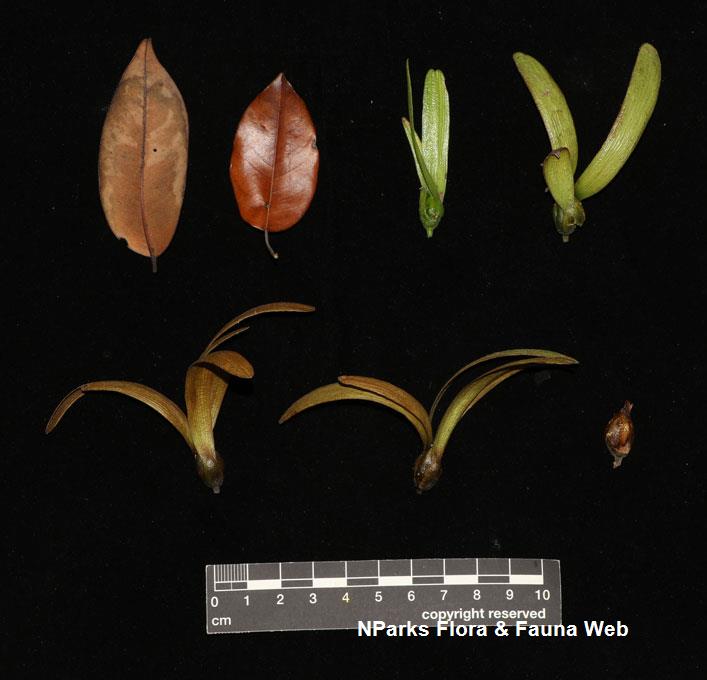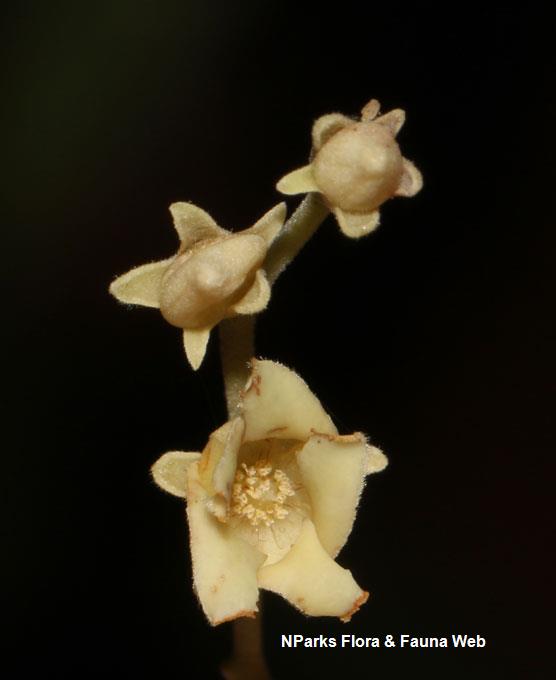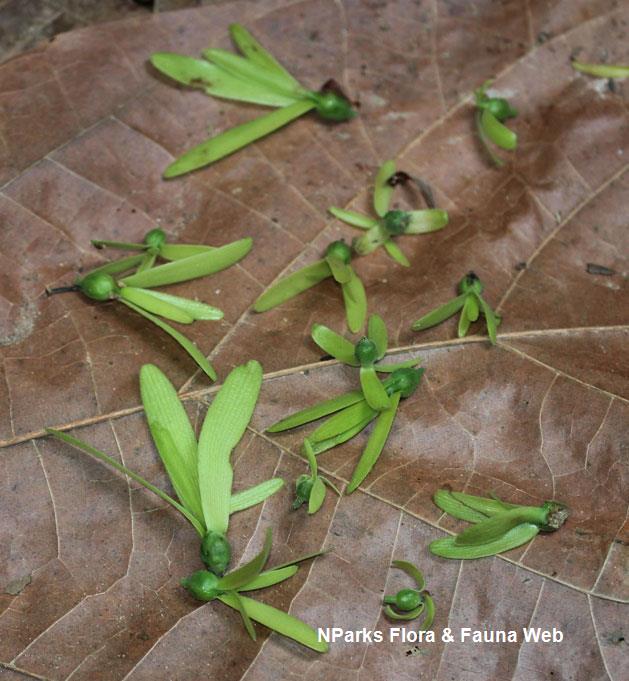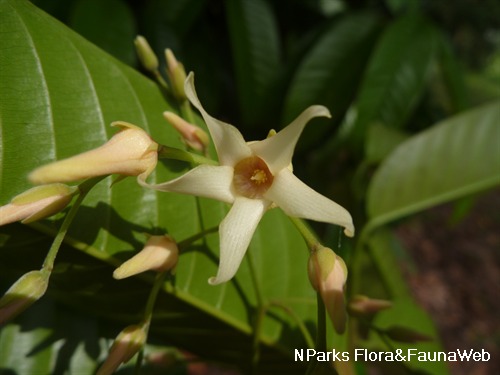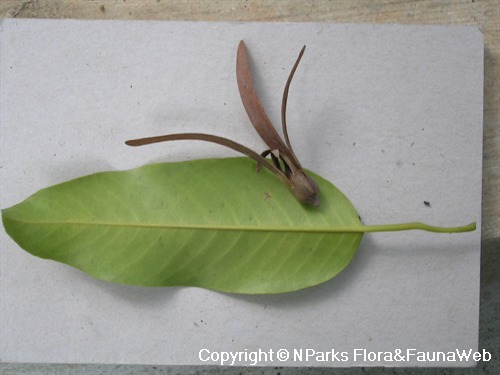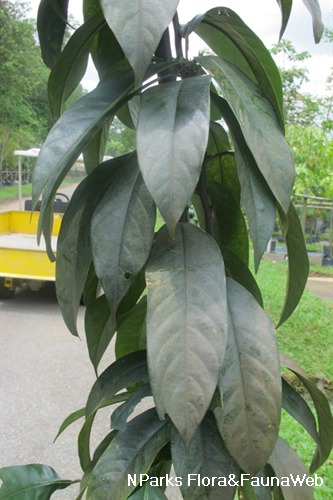
Back
Anthoshorea gratissima (Wall. ex Kurz) P.S.Ashton & J.Heck.
| Family Name: | Dipterocarpaceae |
| Synonyms: | Shorea gratissima (Wall. ex Kurz) Dyer |
| Common Name: | Meranti Laut, Penggiran |
Name
Classifications and Characteristics
| Plant Division | Angiosperms (Flowering Seed Plants) (Dicotyledon) |
|---|---|
| Plant Growth Form | Tree (Big (>30m)) |
| Lifespan (in Singapore) | Perennial |
| Mode of Nutrition | Autotrophic |
| Plant Shape | Irregular |
| Maximum Height | 60 m |
Biogeography
| Native Distribution | Thailand, Sumatra, Peninsular Malaysia, Singapore, and Borneo |
|---|---|
| Native Habitat | Terrestrial (Primary Rainforest, Coastal Forest) |
| Preferred Climate Zone | Tropical |
| Local Conservation Status | Native to Singapore (Critically Endangered (CR)) |
Description and Ethnobotany
| Growth Form | It is a tree up to 60 m tall. |
|---|---|
| Foliage | Its alternate, stalked leaves have leathery leaf blades that are oval or egg-shaped, brown above and yellowish-brown below when dry, and 4-10 by 2.5-4.5 cm. |
| Flowers | Its flowering shoots are up to 10 cm long, and bear up to 8 white or white-pink flowers. |
| Fruit | Its ovoid fruit consists of a nut that is 8-15 by 6-8 mm, with 3 longer wings that are 4.8-7 by 1-1.3 cm and 2 shorter wings that are 2.5-5.5 by 0.5-0.6 cm. |
| Habitat | It grows in forests on dry hills near the coast. It occurs locally in Bukit Timah Nature Reserve. |
| Associated Fauna | Its flowers are insect-pollinated. |
| Etymology | The specific epithet gratissima is Latin for very pleasing, the reference to which is unknown. |
| Ethnobotanical Uses | Timber & Products: It is a source of timber and resin. |
Landscaping Features
| Landscaping | It is suitable for parks. |
|---|---|
| Landscape Uses | Parks & Gardens |
Fauna, Pollination and Dispersal
| Pollination Method(s) | Biotic (Fauna) |
|---|---|
| Seed or Spore Dispersal | Abiotic |
Plant Care and Propagation
| Light Preference | Full Sun |
|---|---|
| Water Preference | Moderate Water |
| Plant Growth Rate | Slow |
| Rootzone Tolerance | Moist Soils, Well-Drained Soils, Fertile Loamy Soils |
| Maintenance Requirements | Moderate |
| Propagation Method | Seed |
Foliar
| Foliage Retention | Evergreen |
|---|---|
| Mature Foliage Colour(s) | Green |
| Mature Foliage Texture(s) | Leathery |
| Foliar Type | Simple / Unifoliate |
| Foliar Arrangement Along Stem | Alternate |
| Foliar Attachment to Stem | Petiolate |
| Foliar Shape(s) | Non-Palm Foliage |
| Foliar Venation | Pinnate / Net |
| Foliar Margin | Entire |
Floral (Angiosperm)
| Flower & Plant Sexuality | Bisexual Flowers |
| Flower Colour(s) | White, Pink |
|---|---|
| Flower Grouping | Cluster / Inflorescence |
| Flower Location | Axillary |
| Flower Symmetry | Radial |
Fruit, Seed and Spore
| Mature Fruit Colour(s) | Brown |
|---|---|
| Fruit Classification | Simple Fruit |
| Fruit Type | Indehiscent Dry Fruit , Nut / Nutlet |
References
| References | Ashton, P.S. & Heckenhauer, J. (2022). Tribe Shoreae (Dipterocarpaceae subfamily Dipterocarpoideae) finally dissected. Kew Bull. 77: 885–903. |
|---|
Image Repository
Others
| Master ID | 31035 |
|---|---|
| Species ID | 5422 |
| Flora Disclaimer | The information in this website has been compiled from reliable sources, such as reference works on medicinal plants. It is not a substitute for medical advice or treatment and NParks does not purport to provide any medical advice. Readers should always consult his/her physician before using or consuming a plant for medicinal purposes. |

